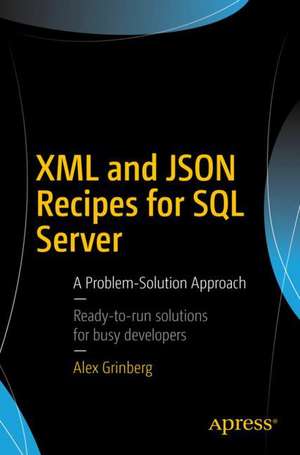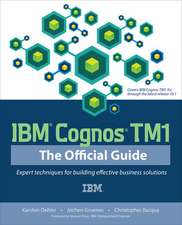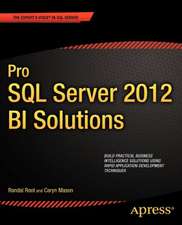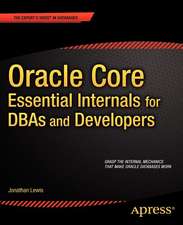XML and JSON Recipes for SQL Server: A Problem-Solution Approach
Autor Alex Grinbergen Limba Engleză Paperback – 19 dec 2017
Quickly find solutions to dozens of common problems encountered while using XML and JSON features that are built into SQL Server. Content is presented in the popular problem-solution format. Look up the problem that you want to solve. Read the solution. Apply the solution directly in your own code. Problem solved!
This book shows how to take advantage of XML and JSON to share data and automate tasks. JSON is commonly used to move data back and forth between the database and front-end applications, often running in a browser. This book shows all you need to know about transforming query results into JSON format, and back again. Also covered are the processes and techniques for moving data into and out of XML format for business intelligence and other purposes, such as when transferring data from a reporting system into a data warehouse, or between different database brands such as between SQL Server and Oracle.
Microsoft intensively implements XML in SQL Server, and in many related products. Execution plans are generated in XML format, and this book shows you how to parse those plans and automate the detection of performance problems. The relatively new Extended Events feature writes tracing data into XML files, and the recipes in this book help in parsing those files.
XML is also used in SQL Server's BI tool set, including in SSIS, SSR, and SSAS. XML is used in many configuration files, and is even behind the construction of DDL triggers. In reading this book you’ll dive deeply into the features that allow you to build and parse XML, and also JSON, which is a specific format of XML used to transmit objects in a web-friendly format between a database and its front-end applications.
What You Will Learn
- Build XML and JSON objects in support of automation and data transfer
- Import and parse XML and JSON from operating system files
- Build appropriate indexes on XML objects to improve query performance
- Move data from query result sets into JSON format, and back again
- Automate the detection of database performance problems by querying and parsing the database’s own execution plans
- Replace external and manual JSON processes with SQL Server's internal, JSON functionality
Who This Book Is For
Database administrators, .NET developers, business intelligence developers, and other professionals who want a deep and detailed skill set around working with XML and JSON in a SQL Server database environment. Web developers will particularly find the book useful for its coverage of transforming database result sets into JSON text that can be transmitted to front-end web applications.
Preț: 370.35 lei
Preț vechi: 462.93 lei
-20% Nou
Puncte Express: 556
Preț estimativ în valută:
70.88€ • 73.72$ • 58.51£
70.88€ • 73.72$ • 58.51£
Carte disponibilă
Livrare economică 24 martie-07 aprilie
Livrare express 08-14 martie pentru 28.08 lei
Preluare comenzi: 021 569.72.76
Specificații
ISBN-13: 9781484231166
ISBN-10: 1484231163
Pagini: 360
Ilustrații: XXIII, 289 p. 128 illus., 117 illus. in color.
Dimensiuni: 155 x 235 x 19 mm
Greutate: 0.37 kg
Ediția:1st ed.
Editura: Apress
Colecția Apress
Locul publicării:Berkeley, CA, United States
ISBN-10: 1484231163
Pagini: 360
Ilustrații: XXIII, 289 p. 128 illus., 117 illus. in color.
Dimensiuni: 155 x 235 x 19 mm
Greutate: 0.37 kg
Ediția:1st ed.
Editura: Apress
Colecția Apress
Locul publicării:Berkeley, CA, United States
Cuprins
Part I: XML in SQL Server.- 1. Introducing XML.- 2. Building XML.- 3. Manipulating XML Files.- 4. Shredding XML.- 5. Modifying XML.- 6. Filtering XML.- 7. Improving XML Performance.- Part II: JSON in SQL Server.- 8. Constructing JSON.- 9. Converting JSON to Row Sets.- 10. Modifying JSON.
Notă biografică
Alex Grinberg has more than 20 years of IT experience. His primary focus is on the latest Microsoft technologies, including .NET (VB and C#), SSRS, and SSIS. He provides tuning, optimization, analysis, and development services toward creating new applications, converting legacy applications into newer technologies such as SQL Server, VB.NET and C#, and toward onsite training. Alex is a senior DBA architect at Cox Automotive Inc. He provides consulting services for the New York City, Philadelphia and Delaware area.
Textul de pe ultima copertă
Quickly find solutions to dozens of common problems encountered while using XML and JSON features that are built into SQL Server. Content is presented in the popular problem-solution format. Look up the problem that you want to solve. Read the solution. Apply the solution directly in your own code. Problem solved!
This book shows how to take advantage of XML and JSON to share data and automate tasks. JSON is commonly used to move data back and forth between the database and front-end applications, often running in a browser. This book shows all you need to know about transforming query results into JSON format, and back again. Also covered are the processes and techniques for moving data into and out of XML format for business intelligence and other purposes, such as when transferring data from a reporting system into a data warehouse, or between different database brands such as between SQL Server and Oracle.
Microsoft intensively implements XML in SQL Server, and in many related products. Execution plans are generated in XML format, and this book shows you how to parse those plans and automate the detection of performance problems. The relatively new Extended Events feature writes tracing data into XML files, and the recipes in this book help in parsing those files.
XML is also used in SQL Server's BI tool set, including in SSIS, SSR, and SSAS. XML is used in many configuration files, and is even behind the construction of DDL triggers. In reading this book you’ll dive deeply into the features that allow you to build and parse XML, and also JSON, which is a specific format of XML used to transmit objects in a web-friendly format between a database and its front-end applications.
What You Will Learn:
- Build XML and JSON objects in support of automation and data transfer
- Import and parse XML and JSON from operating system files
- Build appropriate indexes on XML objects to improve query performance
- Move data from query result sets into JSON format, and back again
- Automate the detection of database performance problems by querying and parsing the database’s own execution plans
- Replace external and manual JSON processes with SQL Server's internal, JSON functionality
Caracteristici
Quick-reference guide that allows you to look up the problem you want to solve and rapidly find and implement the solution Covers JSON features, including how to build JSON from query result sets Covers XML features such as parsing, loading, and more Provides many step-by-step examples that you can adapt to your needs Demonstrates the use of XML and JSON for daily activities of DBAs and developers





















